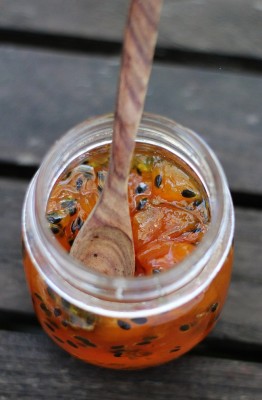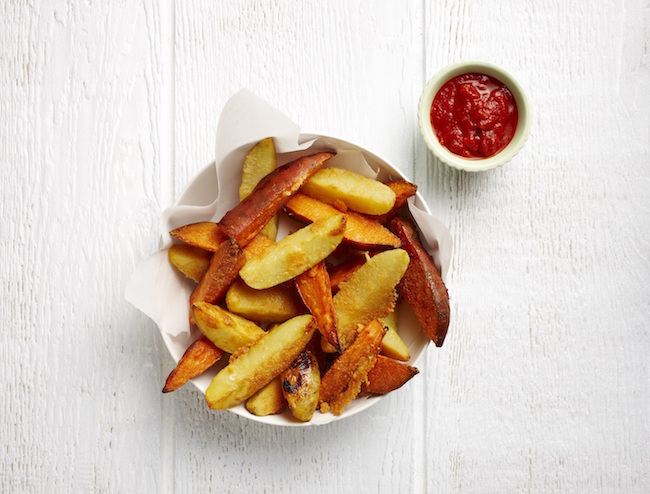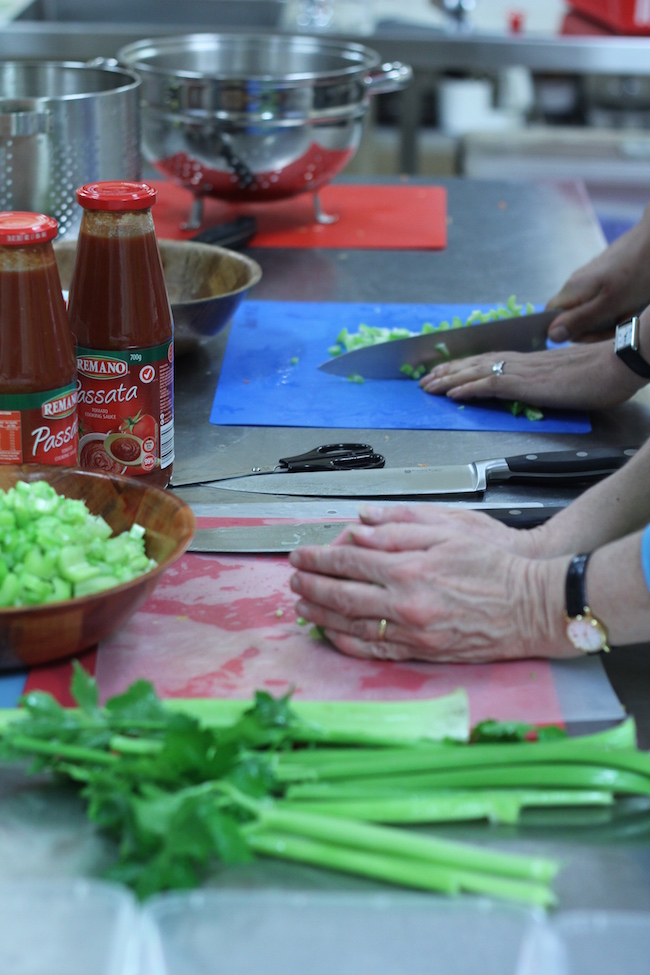
Make Jam
I love the abundance of summer seasonal fruit, particularly stone fruit. And Mother Nature has been particularly generous this year as the peaches have been absolutely divine. Because they’ve been so abundant, and as a result well priced, I thought it was time I revisited Peach and Passionfruit Jam; a beautiful creation, the origins of which come from the Country Women’s Association (CWA) Preserves cookbook, but which I found a few years ago shared by Liz on Bizzy Lizzy’s Good Things

Summery deliciousness
It’s a divine jam, which for me epitomises the delicious sweetness of summer, and draws out summer memories despite the shortening of the days and cooling of the nights. My only disappointment is a jar just doesn’t last long enough.
Do you love seasonal cooking? Have you a favourite recipe you can’t wait to revisit each year?
Peach and Passionfruit Jam*
Makes around 8-10 cups
- 1.25 kg yellow peaches, peeled and cut into small dice
- 1.25 kg sugar (you can use less than this for a tarter finish)
- Juice of ½ medium lemon (Liz used the whole lemon and so did I)
- pulp from 12 passionfruit
Arrange your peaches in a bowl layered with some of the sugar. Leave overnight and refrigerate if you like. [Note: this step may be optional. The last time I made it I was short on time and simply left the fruit and sugar for a couple of hours. My jam was still perfect.]
In a heavy based pan, cook your peaches. While the peaches are cooking, pre-warm remaining sugar. Add warm sugar along with the warmed lemon juice and passionfruit pulp once peaches are soft. Boil quickly until it jells when tested. Pop a saucer in the freezer to test this.
Pour jam into sterilised jars and seal [I always make an absolute mess when I do this. Liz recommended carefully transferring the jam to a large pyrex jug and it worked a treat]. Store your jam in a cool, dark place, it should keeps for at least 12 months and up to 2 years – not sure who could ever keep it this long, just eat it!
*Original recipe adapted from Country Women’s Association (CWA) Preserves: Traditional, Tempting, Tried-and-True (Penguin)

Just eat it!
xx Karen

Enjoy dairy
I was lucky enough hear one of the world’s biggest gurus on calcium, Professor Connie Weaver speak at a symposium hosted by Dairy Australia last month.
As our best and most available source of dietary calcium, you can’t really avoid talking dairy if you want to talk about dietary calcium.
So what did I learn and what can I share?
- Interestingly, while many of us avoid dairy to maintain our weight, lower blood cholesterol or reduce the risk of type 2 diabetes, research actually shows regular dairy habit (milk, yoghurt, cheese) is linked to a reduced risk of
- heart disease
- stroke
- type 2 diabetes
- high blood pressure
- some cancers
- bone fracture
- When milk is a source of calcium in our children’s growing years they’re likely to have bigger, denser and stronger bones.
- People who are regular dairy consumers tend to have better diets overall.
- To absorb the same amount of calcium as a glass of milk you’d need to eat over 9 cups of kidney beans, 8 cups of spinach or 1 cup of almonds – phew, that’s hard work!
- Dairy can still be an option if you’ve lactose intolerance; Swiss, cheddar and other hard types of cheeses have minimal lactose and should be well managed by all except the most sensitive.
- Half of our adult bone mass is accrued during adolescence; take home here is the teen years are critical for strong bones in later life
When 8 out of 10 Australians don’t get their daily recommended serves of dairy, my worry is for our children who have so much to gain from a diet that gives them enough calcium to develop a hardy skeleton.
To spur on the dairy lover in you and your family here are a couple of lovely recipes to share.
Eat, enjoy and grow strong bones.
Xx
Karen
Roasted Parmesan wedges
Serves 4
- 300g potatoes well scrubbed
- 300g orange sweet potato, well scrubbed
- 1 tsp oil
- 40g finely grated Australian parmesan cheese
Cut each potato into 6-8 chunky wedges and place in a microwave steamer with 2 tablespoons water. Cook on HIGH for 5 minutes, until par-cooked. Drain and stand for 10 minutes.
Toss potatoes in a bowl with oil and cheese until coated. Transfer to a baking paper lined tray and roast at 180°C for 30 minutes or until cooked and golden. Serve hot from the oven.

Wedges are a real hit with kids
Beetroot lentil and feta salad
This salad is a particular favourite of mine and it always gets comments as it tastes as good as it looks.
Serves 6
- 450g can whole baby beetroot drained
- 400g can lentils, drained and rinsed
- 2 spring onions (shallots) finely sliced
- 50g wild rocket
- 2 tsp olive oil
- ¼ cup crumbled fetta cheese
- freshly ground pepper to taste
Cut any larger beetroot in half and combine with lentils and spring onions in a bowl.
Add the rocket and drizzle with combined oil and vinegar. Gently toss to coat.
Transfer salad to a serving platter, scatter with feta and a grinding of pepper.

It tastes as good as it looks
Tip
This salad makes a great addition to the Christmas table. Try roasting your own beets and add a handful of walnuts to make it even more special.
I attended the Dairy Australia Scientific Symposium as a guest of Dairy Australia and the above recipes are two of my personal favourites from Dairy Australia’s Healthy Recipes with dairy Foods
xx Karen

Know: your community
It’s easy to get caught up in first world problems and assume this is how it is for most.
But it was with new insight that I spent an evening with an inspirational bunch of women from The Sisterhood in the local parish kitchen preparing food for disadvantaged families on behalf of GIFT.
Three hours, 7 women, 100 meals…

Many hands make light work
It was that simple.
Distributed by the local Link Community Food Care Centre and St Vincent de Paul the meal packs we prepared also included a recipe sheet; just in case families wanted to cook it again.
Organisations such as these are in increasing demand despite the fact that Australia was ranked second in the world for average wealth in 2013.
The fact is that poverty in this ‘wealthy’ country of ours continues to increase. One in seven Australians live below the poverty line according to the latest report of the Australian Council of Social Service. Even more disturbing is that this effects one in six of our children.
It’s highly likely someone down your street is struggling.
Want to help?
We have some great national organisations looking out for Australians in need and they are always looking for more support:
But why not look into your own community. I’m sure you’ll find some fabulous groups doing some amazing things.
Money is always in demand but for me, finding time to give is really the ultimate gift…

100+ meals….














